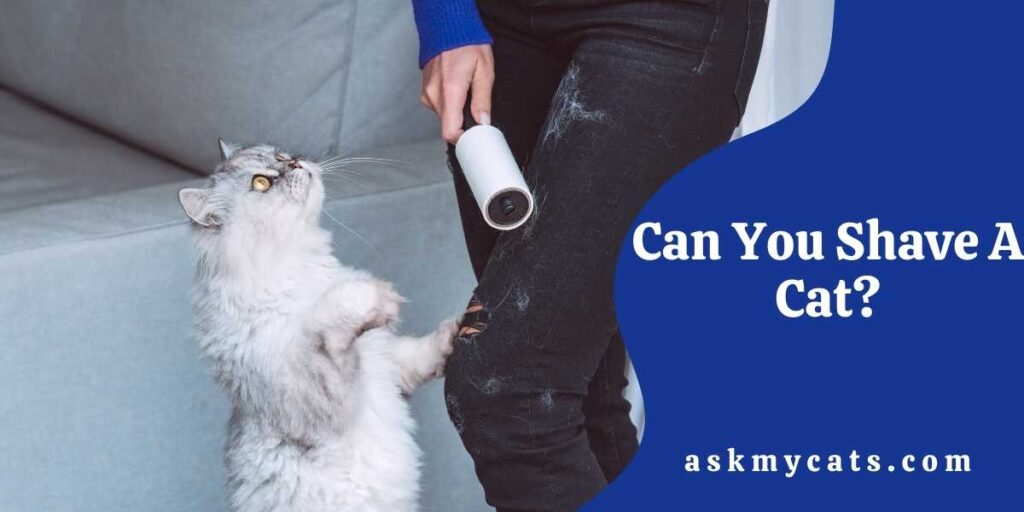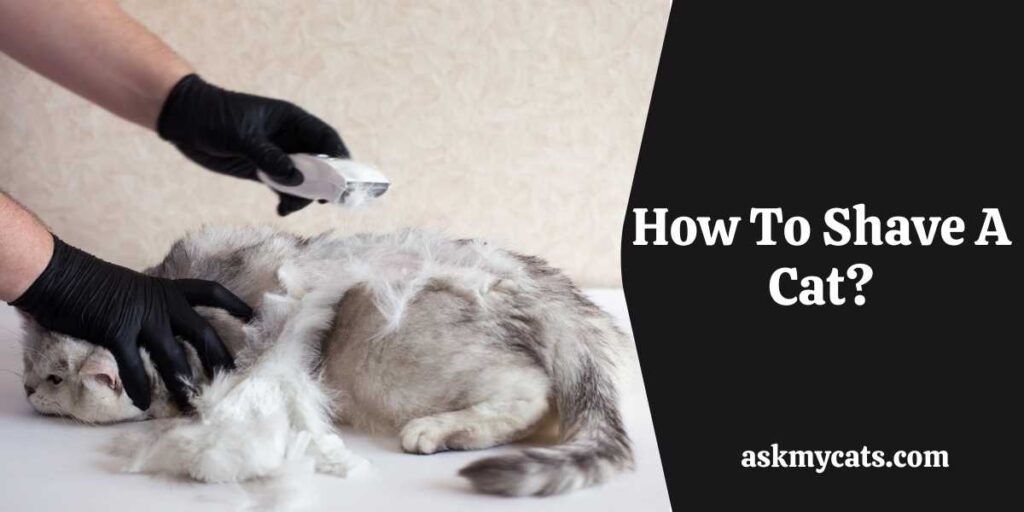Have you ever wondered whether you could shave a cat because you were tired of shedding, worried your cat was hot or had matted fur?
Shaving your cat may be an unpleasant and stressful process, and it is not something you should do at home.
Trimming or shaving is not a natural need for cats. A cat’s coat can normally be left alone as long as you brush it periodically to remove stray hair and avoid tangles and mats.
Although certain dog breeds have hair that grows constantly and has to be trimmed on a regular basis, a cat’s fur is different.


Give Your Cat the Perfect Day
Get the Free Ebook!
Should You Shave Your Cat?
You should not shave your cat.

Cats have a built-in insulator in the form of their hair. They may stay warm in the winter and cool in the summer because of this self-regulating system. Isn’t nature incredible?
It’s still crucial to keep your cat hydrated with fresh water, but it’s not necessary to shave your cat.
Plus, cats are smart enough to seek for shade when they become overheated.
If you suspect overheating, contact a reputable veterinarian; symptoms may include (but are not limited to) difficulty breathing, heavy panting, an increased heart rate, vomiting, lethargy, stumbling gait, and drooling.
It’s a simple fact: cats shed, and short-haired cats shed exactly as much as long-haired cats – the long hair is just more noticeable.
Shedding, in fact, is a sign of a healthy feline.
You may believe that shaving your cat is the most effective method to prevent shedding, but there are other options.
Brushing your cat on a regular basis will help to decrease the quantity of hair that ends up on your furniture and clothes.
Furthermore, a high-protein diet keeps a cat’s coat healthy and reduces shedding. Because hair is made out of keratin, a protein, this makes sense.
There are easier ways to get rid of matting than shaving your cat. Long-haired cats are more likely to have matted fur than short-haired cats. These mats can develop as a result of either the cat’s or the human’s infrequent brushing.
Brushing your cat on a daily basis can help prevent mats from forming in the first place, especially if your cat has long fur. Brushing the kitty’s coat is not only good for his coat, but it also helps the cat and his owner’s bond.
Check out more details about can i shave my cat to get rid of fleas
Mats can also form when a cat is overweight and can’t reach particular parts of his body when grooming. Mats might form that are painful to the kitten and make him feel uneasy.
Obesity is less likely in cats who consume a high-protein diet and exercise regularly. If you feel your cat is overweight, get advice from your veterinarian.
Small mats may frequently be eliminated by untangling the hair with your fingers or a brush. If this isn’t an option, get your cat groomed by a professional groomer or veterinarian.
You run the danger of hurting the cat’s delicate skin and/or causing unneeded feline anxiety unless you’ve been trained to do so.
You might also like to read about can you shave a cat with human clippers
Is It Cruel To Shave Your Cat?
It is cruel if you are unnecessarily shaving your cat.

Yes, you can shave a cat, but only under very particular circumstances, you should do so. There may be instances when your cat has to be shaved, however, this is usually due to medical need or pain.
Some of the other reasons you might contemplate the surgery can be avoided with daily brushing and good nutrition, but always leave the clippers and scissors to a competent expert.
Because the cat’s skin is so thin due to age and/or health conditions, shaving is risky. There’s a good chance you’ll nick or cut the cat.
Shaving the fur off necessitates getting a clipper blade extremely near to the cat’s skin, and the pelt can occasionally obscure the ability to see what’s below.
Also, check out should i shave my cat in summer
Shaving Cats: Pros And Cons
Benefits Of Shaving Cats
It goes without saying that a shaved cat will create less scattered hair than a typical cat. As a consequence, you’ll have an easier time managing your pet during the shedding season.
No one enjoys seeing cat fur all over the home, so shaving is a good way to avoid that. While cats shed regardless of how they groom their coats, the amount of hair shed would be small.
Shaving is a godsend for pet owners who despise dealing with clogged vacuum cleaners and fur-covered furnishings.
Cats are known for their meticulous grooming, and they will spend hours grooming themselves from head to toe. However, because these creatures lick their bodies, they swallow a lot of body hair by accident, resulting in hairballs in the long term.
Needless to say, hairballs are a major source of discomfort for cats, and the incidence of hairballs rises dramatically during shedding seasons. Shaving your pet’s coat is the easiest technique to assure that it will not get hairballs in the near future.
Senior cats, as well as cats who have muscular problems, have a difficult time grooming themselves. The prolonged absence of body grooming would have detrimental effects on the coat of such cats over time.
In terms of remedies, a trimmed coat should be enough. You can keep your cat’s matted fur in check and give it a tidy appearance by storing it.
As your automobile becomes older, shaving on a regular basis may be the greatest way to supplement your old pal’s diminishing capacity to groom itself.
Drawbacks Of Shaving Cats
Cats dislike being touched or confined by strangers, thus a shaving procedure might be traumatic for them. Certain cats hide for days after being shaved, seeking to adjust to their new appearance.
Furthermore, as a result of the experience, some cats may begin to view their human caregivers in an unfavorable manner. As a result, it’s usually recommended that you consider your cat’s temperament and personality.
Don’t overwork the cat since it will damage the bond between the animal and the owner.
As previously said, your pet’s coat covers the underneath skin from potential dangers, and shaving the coat will expose the cat fully.
Shaving, at most, can cause inflammation and other skin problems. In the worst-case scenario, your cat might develop skin cancer.
You should be able to reduce the danger by taking your cat to the vet for an inspection and advice every now and then. In any event, shaving exposes your cat’s skin to risks, therefore it’s critical to keep a watchful eye on him.
How To Shave A Cat?

You can get your cat shaved at a groomer, but if you prefer to do it yourself, bear in mind that each cat is different, and some will be more resistant to shaving than others.
Make sure your cat has a safe and comfortable shave by following these recommendations and procedures:
- Trim Her Nails First
- Test the sound of the clippers
- Hold the Skin Taut
- Start at the top of the cat’s body
- Hold your cat gently, but firmly
Shave around and beneath matted fur by holding it by its end and gently moving it from side to side. You may be able to reach the mat easier from one angle or numerous angles, depending on how near it is to the skin.
Continue to move it carefully and progressively cut it until it comes free. If at all possible, have a helping hand pull the skin surrounding it flat to prevent it from rising up into the mat and being sliced.
It takes a long time for the hair on your cat’s tail to regrow. Unless your hair is matted or you need to shave it for surgery, let it long to prevent having to shave it.
If you do need to shave it, try to confine it as little as possible; cats that are unable to move their tails might get quite angry.
Cat Behavior After Shaving
Cats can start acting hyper after getting a shave.
It’s conceivable that your cat is uncomfortable, itchy, or sensitive in certain places of her skin as a result of her recent shave, but there’s no way to know for sure without further information, a physical exam, and potentially even bloodwork.
Frequently Asked Questions
How much does it cost to get a cat shaved?
Grooming your cat is a crucial aspect of keeping them in excellent health. The typical cost of cat grooming in the United States is between $50 and $70, depending on where you reside and what services you need. Grooming costs are also affected by your cat’s disposition.
How often can you shave a cat?
Long-haired and medium-haired cats have higher grooming needs, which increase during shedding seasons when cats lose more hair. Long-haired and medium-haired cats should be groomed on a daily basis, whilst short-haired cats should be groomed once a week.
Can you shave an indoor cat?
Even if your cats have long or black fur, shaving them for heat concerns isn’t essential if they live an indoor-only lifestyle. It’s considerably better to leave your long-haired or dark-colored kitten indoors than it is to shave him if you’re worried he’ll become too hot outside.
Final Words
Grooming your cat on a regular basis can help avoid matting and the need to shave your cat.
To assist avoid this painful operation, maintain adequate grooming at all times. If shaving becomes essential, take care not to startle your cat, and you’ll both feel more at ease with her fur.
Ask your questions in the comments section below.
